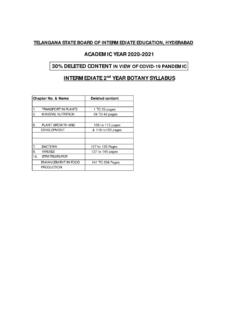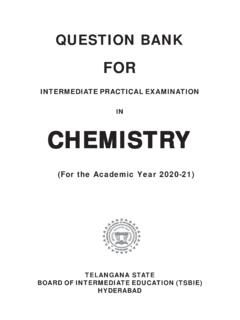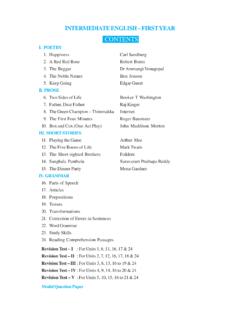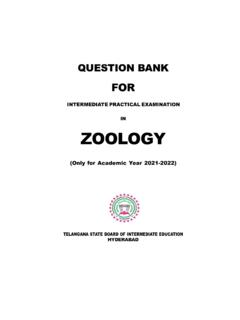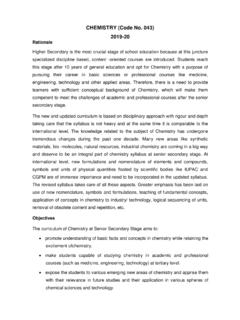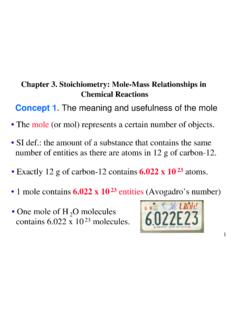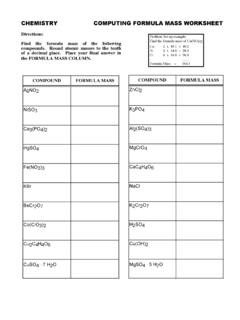Transcription of ACADEMIC YEAR 2020-2021 - Centre for Good Governance
1 TELANGANA STATE BOARD OF INTERMEDIATE EDUCATION, HYDERABAD ACADEMIC year 2020-2021 70% CONTENT IN VIEW OF COVID-19 PANDEMIC INTERMEDIATE 1st year BOTANY SYLLABUS UNIT CHAPTER NO TOPIC 1 2 3 4 Diversity in the living world What is living Diversity in living world Biological classification kingdom of Monera kingdom of Protista kingdom of Fungi Kingdom Plantae kingdom of Animalia Six kingdom classification Viruses, Viroid, Prions and Lichens Science of Plants- Botany Origin Development Scope Branches Plant kingdom Algae Bryophytes Pteridophytes Gymnosperms Plant life cycles and Alternation of Generations II 5 Morphology of flowering plants The Inflorescence The flower III 7 Sexual Reproduction in Flowering Plants Pre fertilization structures and events Pollination pollen pistil interaction Double fertilization Post fertilization structures and events
2 Special modes Apomixis, Parthenocarpy and Polyembryony IV 8 Plant Systematics Systems, Types of classification Semi technical description of a typical flowering plant Description of some important families Solanaceae Liliaceae V Cell structure and Functions 9 Cell- the Unit of Life 10 Biomolecules 11 Cell Cycle and Cell division VI 12 INTERNAL ORGANISATION OF PLANTS Anatomy of Dicotyledonous and monocotyledonous Plants Dicotyledonous root Monocotyledonous root Dicotyledonous stem Monocotyledonous stem VII 13 Plant Ecology Introduction Plant
3 Communities and Ecological Adaptations ** TELANGANA STATE BOARD OF INTERMEDIATE EDUCATION, HYDERABAD ACADEMIC year 2020-2021 70% CONTENT IN VIEW OF COVID-19 PANDEMIC INTERMEDIATE 1st year BOTANY PRACTICAL SYLLABUS TELANGANA STATE BOARD OF INTERMEDIATE EDUCATION, HYDERABAD ACADEMIC year 2020-2021 70% CONTENT IN VIEW OF COVID-19 PANDEMIC INTERMEDIATE 1st year CHEMISTRY SYLLABUS Chapter 1 atomic STRUCTURE Developments leading to the Bohr s model of atom Bohr s model for hydrogen atom Dual Behaviour of matter (Broglie s equation) Heisenberg s Uncertainty principle quantum numbers, energies of orbitals - filling of orbitals in atom.
4 Aufbau Principle, Pauli s exclusion principle and Hund s rule of maximum multiplicity- electronic configurations of atoms-stability of completely filled and half filled subshells. Chapter 2 CLASSIFICATION OF ELEMENTS AND PERIODICITY OF PROPERTIES Modern periodic law and the present form of periodic table, Nomenclature of elements with atomic number greater than 100. Electronic configuration of elements and the periodic table Electronic configuration and types of elements and f blocks periodic trends in properties of elements - atomic radii, ionic radii, inert gas radii, Ionization enthalpy, electron gain enthalpy, electronegativity, valency.
5 Chapter 3 CHEMICAL BONDING AND MOLECULAR STRUCTURE Kossel Lewis approach to chemical bonding Ionic or electrovalent bond Bond parameters VSEPR theory: predicting the geometry of simple molecules Valence bond theory Hybridisation Coordinate bond-definition with examples Molecular orbital theory bonding in some homonuclear diatomic molecules Hydrogen bonding Chapter 4 STATES OF MATTER: GASES AND LIQUIDS Intermolecular forces Thermal energy Intermolecular forces Vs thermal interactions The gaseous State.
6 The gas Laws Ideal gas equation. Grahams Law of diffusion Dalton s law of partial pressures Kinetic molecular th eory of gases Kinetic gas equation of an ideal gas (No derivation ) deduction of gas laws from kinetic gas equation Behaviour of real gases: deviation from ideal gas behaviou r comp ressibility factor Vs pressure diagrams of real gases. Chapter 5 stoichiometry Importance of Chemistry-Some basics atomic and molecular masses - mole concept and molar mass concept of equivalent weight Percentage composition of compounds and calculations of empirical and molecular formulae of compounds.
7 stoichiometry and stoichiometric calculations. redox reations oxidation number concept types of redox reactions balancing of redox reactions- oxidation number method of reaction(ion- electron) method. Chapter 6 THERMODYNAMICS Thermodynamic terms work- enthalpy Extensive and intensive properties - Measurement of U and H: Calorimetry Enthalpy change, r H of a reaction Enthalpies for different types of reactions Spontaneity Gibbs energy change and equilibrium. Absolute Entropy and the third law of thermodynamics Chapter 7 CHEMICAL EQUILIBRIUM AND ACIDS BASES Equilibrium in physical process.
8 Equilibrium in chemical process-dynamic equilibrium Law of chemical equilibrium - law of mass action and equilibrium constant Homogeneous equilibria constant in gaseous system, relation between Kp & Kc Heterogeneous equilibria applications of equilibrium constant Factors affecting Equilibria- Le-chatelier s principle-Application to industrial synthesis of ammonia and sulphur trioxide Ionic equilibrium in solutions Acids and bases and salts Arrhenius, Bronsted Lowry and Lewis concepts of acids and bases Buffer solutions-designing of buffer solution- preparation of acidic buffer Solubility equilibria of sparingly soluble salts solubility product constant , common ion effect on solubility of ionic salts.
9 Chapter 8 HYDROGEN AND ITS COMPOUNDS Position of hydrogen in the periodic table and isotopes Hydrides: ionic, covalent and non stoichiometric hydrides Physical and chemical properties of water, heavy water hydrogen as a fuel. Chapter 9 S BLOCK ELEMENTS: ALKALI AND ALKALINE EARTH METALS Group I Elements: Alkali metals; electronic configurations; atomic and ionic radii; ionization enthalpy; hydration enthalpy; physical properties; chemical properties; uses General characteristics of the compounds of the alkali metals: oxides; halides; salts of oxy acids Anomalous properties of lithium: Alkaline earth metals; electronic configuration; ionization enthalpy; hydration enthalpy; physical properties.
10 Chemical properties; uses. General characteristics of compounds of the alkaline earth metals Anomalous behaviour of beryllium; its diagonal relationship with aluminum. Chapter 10 P- BLOCK ELEMENTS:GROUP-13 BORON FAMILY General introduction electronic configuration, atomic radii, ionization enthalpy ,electro negativity; physical and chemical properties Important trends and anomalous properties of boron. Chapter 11 P - BLOCK ELEMENTS: GROUP-14 CARBON FAMILY General introduction - electronic configuration, atomic and covalent radii, ionization enthalpy, electro negativity; physical and chemical Important trends and anomalous properties of carbon Allotropes of carbon Uses of carbon.


